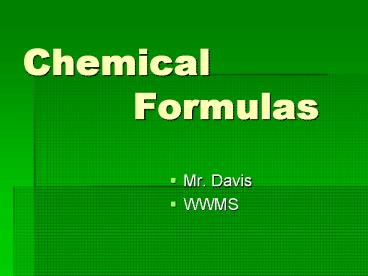Chemical Formulas PowerPoint PPT Presentation
1 / 15
Title: Chemical Formulas
1
Chemical Formulas
- Mr. Davis
- WWMS
2
New substances are formed in a chemical reaction
because chemical bonds in the starting
substances break, atoms rearrange,
and new bonds form to make the new
substances.
3
A chemical formula is a shorthand notation for a
compound or a diatomic element using chemical
symbols and numbers.
4
(No Transcript)
5
Rules for naming covalent compounds
- Add a prefix to the first compound (excluding
mono-) based on its subscript - Add a prefix to the second compound name based on
its subscript
6
Rules for naming covalent compounds
- Add the suffix ide to the end of the second
compound.
7
Seven Diatomic ElementsMust have 2 atoms in
order to exist
- Hydrogen-
- H2
- Nitrogen-
- N2
- Oxygen-
- O2
- Fluorine-
- F2
- Chlorine
- Cl2
- Bromine
- Br2
- Iodine
- I2
8
Funky NamesOnes you have to memorize!!!
- Water-
- H2O
- Ammonia-
- NH3
- Methane-
- CH4
- Hydrogen Peroxide-
- H2O2
9
Classwork Write the formula or name for each
covalent compound.
- 1. NaBr
- 2. P2O5
- 3. SO2
- 4. SiO2
- 5. B2Br4
- 6. CCl5
- 7. Sodium monoxide
- 8. Lithium monoxide
- 9. Potassium monoxide
- 10.Silver monobromide
- 11. Calcium monobromide
10
- 1. NaBr- sodium monobromide
- 2. P2O5- diphosphorus pentaoxide
- 3. SO2- sulfur dioxide
- 4. SiO2- silicon dioxide
- 5. B2Br4- Diboron tetrabromide
- 6. CCl5- Carbon pentachloride
- 7. Sodium monoxide- NaO
- 8. Lithium monoxide- LiO
- 9. Potassium monoxide- KO
- 10.Silver monobromide- AgBr
- 11. Calcium monobromide- CaBr
11
- antimony tribromide SbBr3
- hexaboron silicide B6Si
- chlorine dioxide ClO2
- hydrogen iodine HI
- iodine pentafluoride IF5
- dinitrogen trioxide N2O3
- ammonia NH3
- phosphorus triiodine PI3
12
- P4S5 tetraphosphorus pentasulfide
- O2 oxygen
- SeF6 selenium hexafluoride
- Si2Br6 disilicon hexabromide
- SCl4 sulfur tetrachloride
- CH4 methane
- B2Si diboron silicide
- NF3 nitrogen trifluoride
13
Reactants ? Products
- 2H2 O2 ? 2H2O
Subscript Tell how many atoms of the
substance you have.
Also called the yields sign, separates the
formulas of the reactants from the formulas of
the products.
Separates the formulas of two or more reactants
or products from one another
Coefficient Tell how many molecules of the
substance you have.
14
- The Law of Conservation of Mass
- Atoms are not created or destroyed during a
chemical reaction.
15
- Scientists know that there must be the same
number of atoms on each side of the equation. To
balance the chemical equation, you must add
coefficients in front of the chemical formulas in
the equation. You cannot add or change
subscripts!

